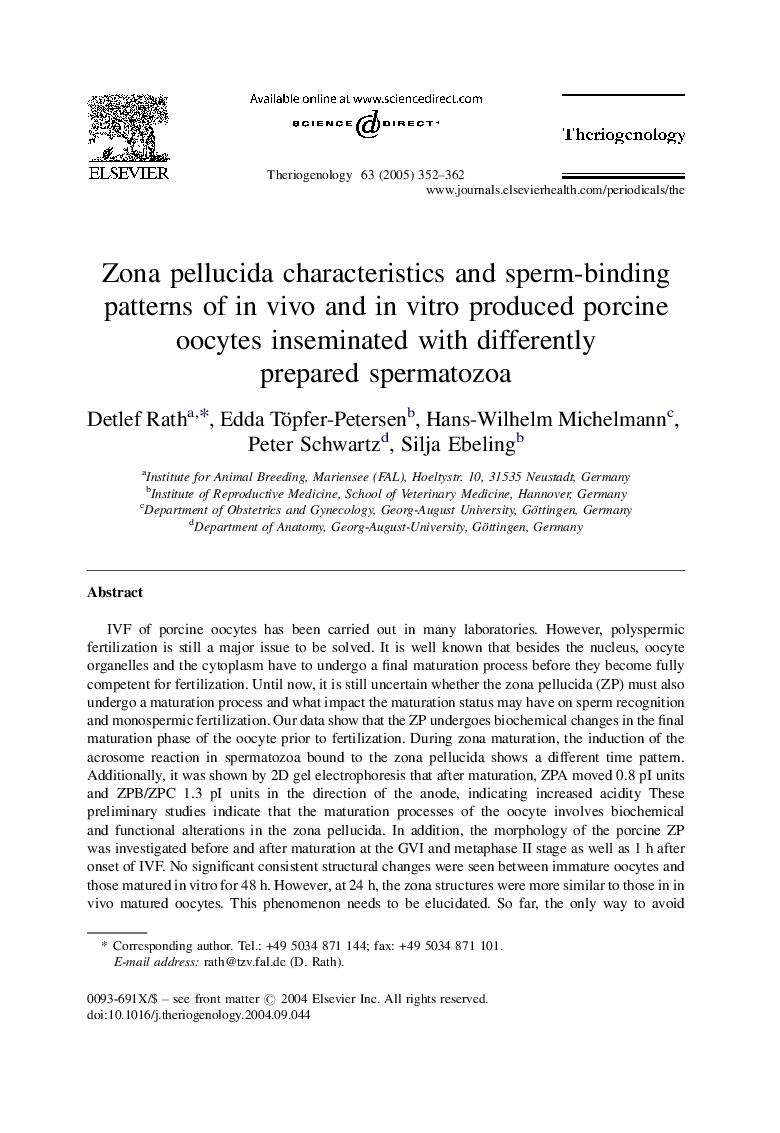| کد مقاله | کد نشریه | سال انتشار | مقاله انگلیسی | نسخه تمام متن |
|---|---|---|---|---|
| 10893339 | 1082199 | 2005 | 11 صفحه PDF | دانلود رایگان |
عنوان انگلیسی مقاله ISI
Zona pellucida characteristics and sperm-binding patterns of in vivo and in vitro produced porcine oocytes inseminated with differently prepared spermatozoa
دانلود مقاله + سفارش ترجمه
دانلود مقاله ISI انگلیسی
رایگان برای ایرانیان
کلمات کلیدی
موضوعات مرتبط
علوم زیستی و بیوفناوری
علوم کشاورزی و بیولوژیک
علوم دامی و جانورشناسی
پیش نمایش صفحه اول مقاله

چکیده انگلیسی
IVF of porcine oocytes has been carried out in many laboratories. However, polyspermic fertilization is still a major issue to be solved. It is well known that besides the nucleus, oocyte organelles and the cytoplasm have to undergo a final maturation process before they become fully competent for fertilization. Until now, it is still uncertain whether the zona pellucida (ZP) must also undergo a maturation process and what impact the maturation status may have on sperm recognition and monospermic fertilization. Our data show that the ZP undergoes biochemical changes in the final maturation phase of the oocyte prior to fertilization. During zona maturation, the induction of the acrosome reaction in spermatozoa bound to the zona pellucida shows a different time pattern. Additionally, it was shown by 2D gel electrophoresis that after maturation, ZPA moved 0.8 pI units and ZPB/ZPC 1.3 pI units in the direction of the anode, indicating increased acidity These preliminary studies indicate that the maturation processes of the oocyte involves biochemical and functional alterations in the zona pellucida. In addition, the morphology of the porcine ZP was investigated before and after maturation at the GVI and metaphase II stage as well as 1Â h after onset of IVF. No significant consistent structural changes were seen between immature oocytes and those matured in vitro for 48Â h. However, at 24Â h, the zona structures were more similar to those in in vivo matured oocytes. This phenomenon needs to be elucidated. So far, the only way to avoid polyspermic penetration is to reduce the number of spermatozoa per oocyte used for IVF. The amount depends on the treatment of the sperm and has to be set for each individual boar.
ناشر
Database: Elsevier - ScienceDirect (ساینس دایرکت)
Journal: Theriogenology - Volume 63, Issue 2, 15 January 2005, Pages 352-362
Journal: Theriogenology - Volume 63, Issue 2, 15 January 2005, Pages 352-362
نویسندگان
Detlef Rath, Edda Töpfer-Petersen, Hans-Wilhelm Michelmann, Peter Schwartz, Silja Ebeling,